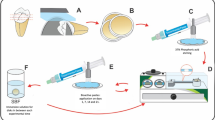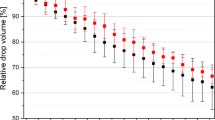Abstract
Objectives
Dentin hypersensitivity (DH) is a prevalent problem. This study aimed to formulate a paste using fluorhydroxyapatite (FA) crystals dispersed in different carriers to treat DH. The ability to occlude patent dentinal tubules and to release ions was investigated.
Materials and methods
Twenty percent FA/sodium alginate, 40 % FA/poly(hydroxyethyl methacylate(HEMA)), and 40 % FA/poly(DMA-co-MEA) were applied to etched dentin samples and examined with scanning electron microscopy (SEM) to determine the degree of tubule occlusion. Fluoride electrode was used to measure F release and spectroscopy to evaluate Ca and PO4 release. The cytotoxicity of the synthesized poly(DMA-co-MEA) gel was tested. Kruskall-Wallis test was used to test the differences in ion release between the groups.
Results
FA/poly(DMA-co-MEA) paste obstructed up to 80 % of the dentinal tubules, while the coverage was up to 70 % for FA/poly(HEMA) and less than 50 % for FA/sodium alginate. Fluoride and Ca release was the highest for FA/P(HEMA), 7.2 ± 0.7 and 139.8 ± 32.5 ppm, respectively. The highest concentration of PO4 was 46.2 ± 16.4 ppm for FA/Sodium alginate. No statistical significance was found.
Conclusions
FA/Poly(DMA-co-MEA) and FA/poly(HEMA) pastes may offer immediate short-term relief of DH because of their ability to occlude the tubules and adhere to wet dentin surfaces. The release of the F, Ca, and PO4 ions may offer long-term relief by forming a mineral barrier both within the dentinal tubules and on the dentin surface.
Clinical significance
The tested materials may offer a long-term treatment for DH.





Similar content being viewed by others
References
(2003) Consensus-based recommendations for the diagnosis and management of dentin hypersensitivity. J Can Dent Assoc 69 (4):221-226
Bamise CT, Olusile AO, Oginni AO (2008) An analysis of the etiological and predisposing factors related to dentin hypersensitivity. J Contemp Dent Pract 9(5):52–59
Chabanski MB, Gillam DG, Bulman JS, Newman HN (1997) Clinical evaluation of cervical dentine sensitivity in a population of patients referred to a specialist periodontology department: a pilot study. J Oral Rehabil 24(9):666–672
Flynn J, Galloway R, Orchardson R (1985) The incidence of ‘hypersensitive’ teeth in the west of Scotland. J Dent 13(3):230–236
Liu HC, Lan WH, Hsieh CC (1998) Prevalence and distribution of cervical dentin hypersensitivity in a population in Taipei, Taiwan. J Endod 24(1):45–47. doi:10.1016/S0099-2399(98)80213-6
Rees JS, Addy M (2004) A cross-sectional study of buccal cervical sensitivity in UK general dental practice and a summary review of prevalence studies. Int J Dent Hyg 2(2):64–69. doi:10.1111/j.1601-5029.2004.00068.x
Rees JS, Jin LJ, Lam S, Kudanowska I, Vowles R (2003) The prevalence of dentine hypersensitivity in a hospital clinic population in Hong Kong. J Dent 31(7):453–461
Clayton DR, McCarthy D, Gillam DG (2002) A study of the prevalence and distribution of dentine sensitivity in a population of 17-58-year-old serving personnel on an RAF base in the Midlands. J Oral Rehabil 29(1):14–23
Fischer C, Fischer RG, Wennberg A (1992) Prevalence and distribution of cervical dentine hypersensitivity in a population in Rio de Janeiro, Brazil. J Dent 20(5):272–276
Poulsen S, Errboe M, Lescay Mevil Y, Glenny AM (2006) Potassium containing toothpastes for dentine hypersensitivity. Cochrane Database Syst Rev 3, CD001476. doi:10.1002/14651858.CD001476.pub2
Cao M, Wang Y, Guo C, Qi Y, Hu C (2004) Preparation of ultrahigh-aspect-ratio hydroxyapatite nanofibers in reverse micelles under hydrothermal conditions. Langmuir 20(11):4784–4786
Chen H, Clarkson BH, Sun K, Mansfield JF (2005) Self-assembly of synthetic hydroxyapatite nanorods into an enamel prism-like structure. J Colloid Interface Sci 288(1):97–103. doi:10.1016/j.jcis.2005.02.064
Chen H, Sun K, Tang Z, Law RV, Mansfield JF, Clarkson BH (2006) Synthesis of fluorapatite nanorods and nanowires by direct precipitation from solution. Cryst Growth Des 6(6):1504–1508. doi:10.1021/cg0600086
Chen HF, Tang ZY, Liu J, Sun K, Chang SR, Peters MC (2006) Acellular synthesis of a human enamel-like microstructure. Adv Mater 18(14):1846
Lee H, Lee BP, Messersmith PB (2007) A reversible wet/dry adhesive inspired by mussels and geckos. Nature 448(7151):338–341. doi:10.1038/nature05968
Gandolfi MG, Silvia F, Pashley DH, Gasparotto G, Carlo P (2008) Calcium silicate coating derived from Portland cement as treatment for hypersensitive dentine. J Dent 36(8):565–578. doi:10.1016/j.jdent.2008.03.012
Chen PS, Toribara TY, Warner H (1956) Microdetermination of phosphorus. Anal Chem 28(11):1756–1758. doi:10.1021/ac60119a033
Prasitsilp M, Siriwittayakorn T, Molloy R, Suebsanit N, Siriwittayakorn P, Veeranondha S (2003) Cytotoxicity study of homopolymers and copolymers of 2-hydroxyethyl methacrylate and some alkyl acrylates for potential use as temporary skin substitutes. J Mater Sci Mater Med 14(7):595–600
Chenoweth MB (1948) The toxicity of sodium alginate in cats. Ann Surg 127(6):1173–1181
Zhang Y, Agee K, Pashley DH, Pashley EL (1998) The effects of pain-free desensitizer on dentine permeability and tubule occlusion over time, in vitro. J Clin Periodontol 25(11 Pt 1):884–891
Petrou I, Heu R, Stranick M, Lavender S, Zaidel L, Cummins D, Sullivan RJ, Hsueh C, Gimzewski JK (2009) A breakthrough therapy for dentin hypersensitivity: how dental products containing 8 % arginine and calcium carbonate work to deliver effective relief of sensitive teeth. J Clin Dent 20(1):23–31
Kumar NG, Mehta DS (2005) Short-term assessment of the Nd:YAG laser with and without sodium fluoride varnish in the treatment of dentin hypersensitivity—a clinical and scanning electron microscopy study. J Periodontol 76(7):1140–1147. doi:10.1902/jop.2005.76.7.1140
Komabayashi T, Imai Y, Ahn C, Chow LC, Takagi S Dentin permeability reduction by a sequential application of calcium and fluoride-phosphate solutions. J Dent 38 (9):736-741. doi: 10.1016/j.jdent.2010.05.019
Claydon NC, Addy M, MacDonald EL, West NX, Maggio B, Barlow A, Parkinson C, Butler A (2009) Development of an in situ methodology for the clinical evaluation of dentine hypersensitivity occlusion ingredients. J Clin Dent 20(5):158–166
Suge T, Kawasaki A, Ishikawa K, Matsuo T, Ebisu S (2008) Ammonium hexafluorosilicate elicits calcium phosphate precipitation and shows continuous dentin tubule occlusion. Dent Mater 24(2):192–198. doi:10.1016/j.dental.2007.03.009
Lee BS, Chang CW, Chen WP, Lan WH, Lin CP (2005) In vitro study of dentin hypersensitivity treated by Nd:YAP laser and bioglass. Dent Mater 21(6):511–519. doi:10.1016/j.dental.2004.08.002
Tomiyama K, Mukai Y, Okada S, Negishi H, Fujihara T, Kawase T, Ueda M, Nakagawa S, Teranaka T (2004) Durability of FTLA treatment as a medicament for dentin hypersensitivity—abrasion resistance and profiles of fluoride release. Dent Mater J 23(4):585–592
Gillam DG, Khan N, Mordan NJ, Barber PM (1999) Scanning electron microscopy (SEM) investigation of selected desensitizing agents in the dentine disc model. Endod Dent Traumatol 15(5):198–204
Sauro S, Gandolfi MG, Prati C, Mongiorgi R (2006) Oxalate-containing phytocomplexes as dentine desensitisers: an in vitro study. Arch Oral Biol 51(8):655–664
Dijkman GE, Jongebloed WL, de Vries J, Ogaard B, Arends J (1994) Closing of dentinal tubules by glutardialdehyde treatment, a scanning electron microscopy study. Scand J Dent Res 102(3):144–150
Absi EG, Addy M, Adams D (1987) Dentine hypersensitivity. A study of the patency of dentinal tubules in sensitive and non-sensitive cervical dentine. J Clin Periodontol 14(5):280–284
Chen W, Chen C, Kung J, Hsiao Y, Shih C, Chien C (2013) Phosphorus effects of mesoporous bioactive glass on occlude exposed dentin. Materials 6(11):5335–5351. doi:10.3390/ma6115335
Rimondini L, Palazzo B, Iafisco M, Canegallo L, Demarosi F, Merlo M, Roveri N (2007) The remineralizing effect of carbonate-hydroxyapatite nanocrystals on dentine. Mater Sci Forum 539–543:602–605
Roveri N, Battistella E, Bianchi CL, Foltran I, Foresti E, Iafisco M, Lelli M, Naldoni A, Palazzo B, Rimondini L (2009) Surface enamel remineralization: biomimetic apatite nanocrystals and fluoride ions different effects. Adv Mater Res 47–50:821
Lee SY, Kwon HK, Kim BI (2008) Effect of dentinal tubule occlusion by dentifrice containing nano-carbonate apatite. J Oral Rehabil 35(11):847–853. doi:10.1111/j.1365-2842.2008.01876.x
Kim JS, Han SY, Kwon HK, Kim BI (2013) Synergistic effect of dentinal tubule occlusion by nano-carbonate apatite and CO2 laser in vitro. Photomed Laser Surg 31(8):392–397. doi:10.1089/pho.2012.3470
Orsini G, Procaccini M, Manzoli L, Giuliodori F, Lorenzini A, Putignano A (2010) A double-blind randomized-controlled trial comparing the desensitizing efficacy of a new dentifrice containing carbonate/hydroxyapatite nanocrystals and a sodium fluoride/potassium nitrate dentifrice. J Clin Periodontol 37(6):510–517. doi:10.1111/j.1600-051X.2010.01558.x
Vano M, Derchi G, Barone A, Covani U (2014) Effectiveness of nano-hydroxyapatite toothpaste in reducing dentin hypersensitivity: a double-blind randomized controlled trial. Quintessence Int 45(8):703–711. doi:10.3290/j.qi.a32240
Lelli M, Putignano A, Marchetti M, Foltran I, Mangani F, Procaccini M, Roveri N, Orsini G (2014) Remineralization and repair of enamel surface by biomimetic Zn-carbonate hydroxyapatite containing toothpaste: a comparative in vivo study. Front Physiol 5:333. doi:10.3389/fphys.2014.00333
Aramendia M, Resano M, Vanhaecke F (2009) Electrothermal vaporization-inductively coupled plasma-mass spectrometry: a versatile tool for tackling challenging samples—a critical review. Anal Chim Acta 648(1):23–44. doi:10.1016/j.aca.2009.06.027
Acknowledgments
University of Michigan electron microbeam analysis laboratory (EMAL), for the use of HRTEM JEOL 3011 (NSF grant #DMR-0315633) and Hitachi S3200N SEM (NSF Grant #EAR-96-28196). This research was supported by a generous grant from the Michigan Universities Commercialization Initiative (MUCI) in 2007
Conflict of interest
The authors declare that they have no conflict of interest.
Author information
Authors and Affiliations
Corresponding author
Rights and permissions
About this article
Cite this article
Taha, S.T., Han, H., Chang, SR. et al. Nano/micro fluorhydroxyapatite crystal pastes in the treatment of dentin hypersensitivity: an in vitro study. Clin Oral Invest 19, 1921–1930 (2015). https://doi.org/10.1007/s00784-015-1427-2
Received:
Accepted:
Published:
Issue Date:
DOI: https://doi.org/10.1007/s00784-015-1427-2




